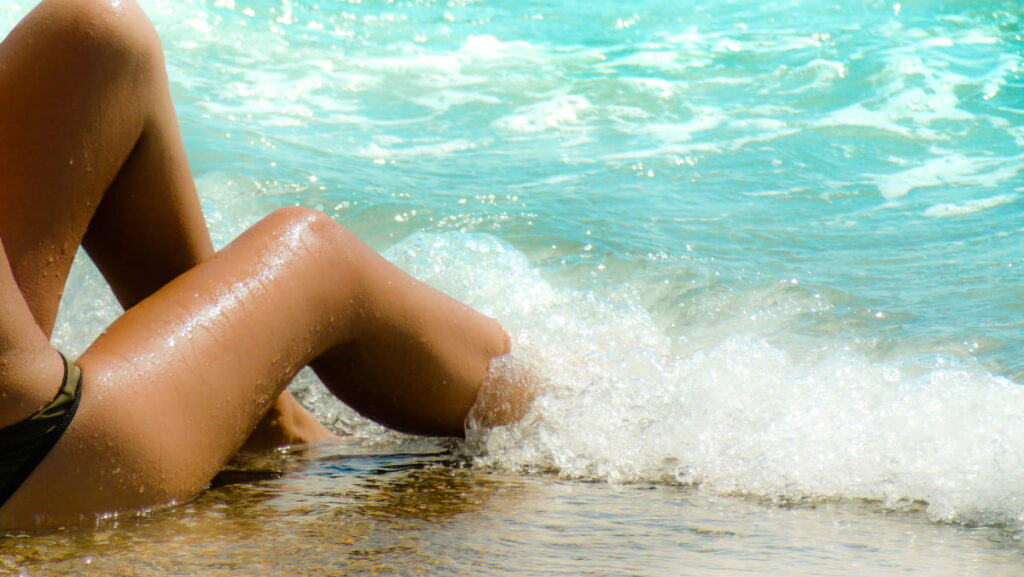
Ever wondered, can you tan through water? It’s a question that might have crossed your mind as you’ve enjoyed a dip in the pool or ocean on a sunny day. Well, the answer isn’t as straightforward as you might think.
Believe it or not, tanning underwater is indeed possible! That’s right – UV rays from the sun can penetrate through water and reach your skin.
However, the depth of the water and its clarity play significant roles in how much of these rays can get to you.
In this article, we’ll dive deeper into this intriguing topic. We’ll explore how UV radiation works, why water affects tanning, and what precautions you should take when spending time in aquatic environments. So let’s jump right in!
The Science Behind Tanning
So, you’re wondering if you can tan through water? Let’s dive into the science behind tanning to answer that.
The process of tanning is all about UV radiation, which comes in two types: UVB and UVA. Your skin produces a pigment called melanin as a response to this radiation. The more melanin your skin has, the darker your tan becomes.
- UVB rays are responsible for causing sunburns and have a stronger link to causing skin cancer.
- UVA rays, on the other hand, penetrate deeper into the skin and trigger melanocytes (the cells that produce melanin) to create more pigment.
It’s important for us now to understand how water factors into this equation. Water actually absorbs UV radiation.
According to research by Marianne Berwick, an epidemiologist at the University of New Mexico, even half a meter under water can absorb up to 25% of UV radiation while one meter deep cuts off around half!
This absorption rate increases significantly with depth, meaning it becomes progressively harder for these rays to reach your skin when submerged in water.

When it comes to the question, “Can your legs tan underwater?” the answer might surprise you. Water absorbs a portion of UV radiation as it penetrates its surface, resulting in decreased UV exposure the deeper you go.
Here’s a breakdown of how UV light gets filtered:
- 0-1 ft underwater: 85-90% UV exposure
- 1-2 ft underwater: 60-65% UV exposure
- 2-3 ft underwater: 40-45% UV exposure
As we can see, submerging our legs underwater will significantly reduce UV exposure, making it harder for our legs to tan.
Yet there’s something else at play here, too – reflection! You’ve probably noticed how sunlight seems brighter around bodies of water; this is due to reflective properties.
In fact, depending upon its angle with respect to the sun and wind conditions on its surface, water can reflect anywhere between 10%-100% incoming sunlight back upwards!
And so it turns out that yes, indeed – you can tan through water albeit not as effectively compared directly beneath sunlight owing primarily because some amount does get absorbed plus reflected away by the surrounding aquatic environment!
How Water Affects UV Exposure
Let’s start by taking an insight into the role of UV radiation in tanning since it is a crucial step to understanding the connection between tanning and water.
Ultraviolet rays can make their way through the skin, triggering it to release melanin in high quantity, which is a black pigment that darkens the skin to provide protection from the harmful rays of the sun.
There are two types of UV radiation that reach the earth’s surface – UVA and UVB. While UVA rays are responsible for immediate tanning, UVB rays contribute to delayed tanning and sunburns.
When you’re submerged in water, your skin is exposed to both refracted and reflected UV rays. When sunlight hits the water, about half of it gets reflected back into space immediately.
The remaining half, the refracted UV rays, enter the body of water and are those that pass through the water and reach your skin.
But there’s another twist! Did you know your wet skin can actually burn faster than dry skin?
It sounds counterintuitive, but here’s why: Wet or damp skin tends to amplify ultraviolet radiation effects because droplets on your skin may behave like tiny magnifying glasses.
So even though you might be cooling off in the pool or ocean – don’t forget about sun protection!
Dangers of Tanning: Not Just A Surface Problem
You might think getting that golden tan is simply about looking good. Unfortunately, it’s more complex and potentially dangerous than that. Let’s dive deeper into the hidden hazards lurking beneath your skin’s surface.
Sun exposure doesn’t just darken your skin tone; it can also cause serious health issues. You’ve probably heard about the risk of skin cancer from excessive sunbathing or tanning bed use.
However, even when you’re underwater – whether in a pool, lake, or ocean – harmful UV rays can still reach your skin.
| Sun Exposure | Potential Risks |
|---|---|
| Short-term | Sunburn |
| Medium-term | Premature aging |
| Long-term | Skin cancer |
Contrary to popular belief, water doesn’t provide a foolproof shield against these rays. In fact, they can penetrate up to three feet underwater!
So if you’re swimming at this depth on a sunny day, you’re still susceptible to the dangers of UV radiation.
Water also has another sneaky way of harming your skin — reflection. It bounces back as much as 25% of the sun’s damaging rays onto parts left exposed above water level, like your face and shoulders!
- Stay hydrated
- Apply waterproof sunscreen regularly
- Limit exposure during peak hours (10 am – 4 pm)
Your skin isn’t just an outer shell; it plays numerous critical roles in maintaining overall health, such as regulating body temperature and protecting against pathogens.
Don’t undermine its importance by chasing after an aesthetically pleasing tan while ignoring potential harm. Remember:
- Water isn’t an effective barrier against harmful UV rays.
- Reflection off the water’s surface intensifies exposure.
- Protecting yourself from sun damage requires active measures even when underwater.
Ultimately, tanning through water isn’t any safer than direct sunbathing – both carry significant risks that need careful management for healthy enjoyment under the sun!
How Sunscreen Works In And Out Of Water
Sunscreen, your best friend during those summer beach trips, is more than just a lotion. It’s a sophisticated shield that protects your skin from the harmful effects of ultraviolet (UV) radiation. But how does it work when you’re taking a dip in the water?
First off, sunscreen primarily functions by absorbing or reflecting UV rays before they can damage your skin cells. The active ingredients – either chemical or mineral-based – are designed to perform this task effectively.
Chemical sunscreens use organic compounds like oxybenzone and avobenzone that absorb UV radiation, transforming it into heat that’s released from the skin.
On the other hand, mineral sunscreens contain particles like zinc oxide or titanium dioxide, which reflect and scatter UV rays away from your skin.
Now here’s where things get interesting: When you take a swim with sunscreen on, its effectiveness isn’t completely washed away.
Most sunscreens these days are water-resistant for up to 40 or 80 minutes underwater, according to FDA regulations.
| Sunscreen Type | Water-Resistance Duration |
|---|---|
| Regular | Not water-resistant |
| Water-Resistant | Up to 40 minutes |
| Very Water-Resistant | Up to 80 minutes |
However, being “water-resistant” doesn’t mean it remains as effective while you’re in water compared to being out of it.
When submerged in water, some sunscreen will inevitably wash off over time, reducing its protective barrier against harmful UV rays.
This is why reapplying sunscreen every two hours is crucial, even if yours claims to be “waterproof” or “sweatproof.”
Remember, there’s no such thing as fully waterproof or sweatproof sunscreen; the FDA banned these terms due to their misleading implications.

Tips for Safe Sun Exposure While Swimming
Before you dive headfirst into your next tanning session, let’s discuss some tips for safe sun exposure while swimming.
Firstly, always apply sunscreen before getting into the water. Water-resistant options are best as they stay on longer when wet. Reapply every two hours or after drying off with a towel.
Secondly, consider the time of day when choosing to swim and tan simultaneously. UV levels are highest between 10 AM and 4 PM, so try to avoid these peak hours if possible.
You may also want to invest in UV-protective swimwear which provides additional protection against harmful rays without hindering your fun under the sun (or under the waves).
Expert Advice On Maintaining Healthy Skin in Summer
When summer rolls around, you’re probably eager to soak up the sun. However, it’s essential to consider your skin health as well.
So, can you tan through water? Yes, but with caution. Keep reading for expert advice on maintaining healthy skin during those sunny months.
Firstly, sunscreen is your best friend when it comes to summer skincare. Even if you’re planning on spending most of your time in the water or under an umbrella at the beach, sunscreen is a must-have.
It not only protects against harmful UV rays that cause premature aging and skin cancer but also helps prevent sunburns.
| SPF | Protection Level |
|---|---|
| 15 | Blocks 93% of UVB rays |
| 30 | Blocks nearly 97% of UVB rays |
| 50+ | Blocks approximately 98% of UVB rays |
Remember to apply sunscreen generously and reapply every two hours or immediately after swimming or sweating heavily.
Secondly, stay hydrated! The heat can deplete your body’s water reserves faster than usual, leading to dry and flaky skin. Drinking plenty of fluids will keep both your body and skin hydrated.
Lastly:
- Seek shade during peak sunlight hours (10 AM -4 PM)
- Wear protective clothing
- Use a lip balm with SPF
- Don’t forget about sunglasses
The goal isn’t to avoid the sun completely – it’s all about moderation and protection while enjoying those beautiful summer days!
Conclusion: Can You Tan Through Water?
So, do you tan faster in water or lying out? The answer majorly depends on factors such as how deep the water is, the position and strength of the sun, and how much of your body is submerged in water.
Tanning while laying out or lounging on a float at the water’s surface will undoubtedly lead to a faster tan, but that’s not to say you can’t get a tan while swimming or wading in the water.
When considering if legs can tan underwater, it’s important to understand how water impacts the sun’s rays.
Water has the ability to absorb and disperse sunlight, thereby decreasing the amount of UV radiation that can reach your skin.
Furthermore, UVB rays—the primary cause of tanning and sunburns—diminish rapidly as they penetrate the water’s surface. As you go deeper, less UVB light is available to cause a tan on your legs.
Despite the reduced amount of UVB light that reaches your legs underwater, UVA rays are more adept at penetrating the water’s surface.
Although they are not as potent as UVB rays, UVA rays still contribute to tanning and skin aging.
Consequently, tanning does occur underwater, but it’s less efficient than when lying out on the beach or by the pool.
Though tanning in the water is possible, it’s important to remember to protect your skin with a water-resistant sunscreen.
This will protect you from dangerous UVA and UVB rays that can cause potential skin damage, premature aging, and skin cancer. Whether swimming, wading, or sunbathing, practicing sun safety is essential to maintain healthy skin.
